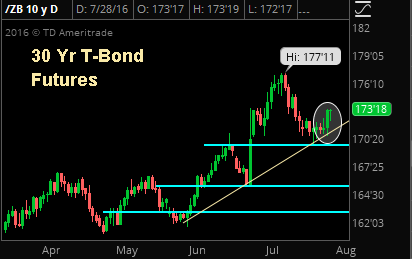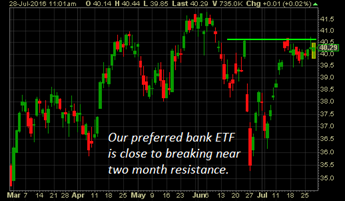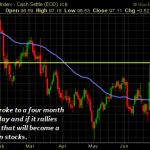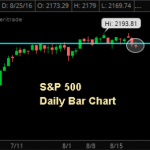Fed Roadmap
When I think about what’s become of the Fed, it almost makes me sad.
I’m dating myself a bit by saying this, but when I started in this business the Fed was a revered (and sometimes feared) institution.
-
In the early 80s, “with a tear” in his eye, Volker rose interest rates and broke inflation.
-
In the 90s, Greenspan was the “maestro” that helped support the best economic run in decades.
-
In the late 00s, Bernanke was steadfast through the crisis.
So, when I saw the market reaction to yesterday’s “hawkish” statement, it made me a little sad, because the market clearly no longer respects the Fed.
And, that makes me nervous.
I say that because while the Fed has successfully engineered massive rallies in both stocks and bonds (and, to a degree, real estate again), at some point things have to begin to return to normal, otherwise we’re going to get another bubble burst.
Yesterday’s price action was scary because it implied the Fed has potentially lost control of the markets, and if that is the case then we are going to see a bubble further inflate and then burst across all asset classes (stocks, bonds, real estate).
Given how fundamentally overvalued stocks and bonds are right now, it’s not unreasonable to think that we could see a 5%, 10% or even 15% decline in both
stocks and bonds (like last August, but worse) if the Fed does lose control and then tries to rein markets back in through a knee-jerk increase in rates.
Is that going to happen next week, or even next month?
No.
The trend in stocks is still higher, and 2200-2240 in the S&P 500 remains a very reasonable near-term target.
But, most of us aren’t investing for the next few weeks or months, we’re investing for quarters and years, and the bottom line is that yesterday’s reaction in stocks might be good in the short term, but beyond that—and unless something changes—we’ve got two unattractive alternatives:
-
The Fed continues to lose credibility
and asset prices simply run higher as the bubble expands, only to ultimately pop at some point.
-
The Fed realizes it has lost credibility and shocks markets with more rate hikes than expected, potentially undermining the whole catalyst for the stock and bond rally.
No one knows how it’ll go, but the important thing is to be reading someone who recognizes these risks, and someone who is watching specific assets and leading indicators that will give us warning when this unsustainable situation comes to a head (and importantly, provides tactical guidance on how to protect client portfolios).
Over the coming weeks and months, we’re going to be doing that for our subscribers because our goal at The Sevens Report is to wake up each day and help our subscribers navigate these complex markets, and provide the best value in market analysis out there today.
I created this report because I know that most financial advisors and professionals are not glued to blinking screens from 9:00 – 4:00 each day.
They are discussing the financial goals of their clients and mapping a financial course to reach those goals. Most of their time is spent building and fostering relationships, not analyzing Fed commentary, studying the yield curve, or digging through an oil inventory report.
The most successful advisors use The Sevens Report
to stay ahead of the markets (stocks, bonds, currencies and commodities) and to make sure their clients are positioned to both outperform while also being protected from any financial “storm” that may blow up.
Specifically, we take complex macro-economic concepts (like FOMC Policy, Brexit, Jobs Report, Italian Bank Risk, etc.) and tell you:
1) What you need to know,
2) What will move markets, and
3) What will make those events positive or negative for stocks and other asset classes.
Every morning at 7 a.m. we deliver this information, so you can show your clients you’re on top of the markets with a plan to outperform, regardless of the environment.
Yesterday the Fed produced a “hawkish” statement that undoubtedly was designed to get markets to respect the possibility of a rate hike this year, but the effort failed, and while that likely will fuel incremental upside in stocks, it lays the foundation for a potentially violent pullback down the road if the Fed wants to regain the market’s respect.
As a courtesy, we have included both of those pieces of analysis for you today:
Why Was the Fed Hawkish but the Market Dovish?
In a somewhat shocking turn of events, the dollar declined following the Fed statement yesterday and Treasuries (including the Fed-sensitive 2 year) rose, which is the exact opposite of what should have happened based on the FOMC statement.

The reason for this opposite reaction is clear: the market does not believe the Fed anymore.
An old saying on Wall Street is, “Markets always tell the truth.” And the truth is that after a year of policy whipsaws, conflicting statements and consistent dovish excuses, the Fed has lost all hawkish credibility—and with good reason.
First, we’ve seen this act before. The Fed was hawkish last July, but balked at hiking in September. Then they were hawkish in December and said to expect three-to-four rate hikes. Then the entire month of May, various Fed speakers chastised the markets for being too dovish (yes, we’re talking to you Rosengren), only to have the FOMC produce a very dovish statement in June. So, the logical question is… “Why should we believe them now?”
Second, who cares about one 25 bps rate hike? Whether there is a rate hike in September or December, the market doesn’t believe the Fed will hike rates consistently beyond that one hike, regardless of what happens to economic growth or inflation. And frankly, why should markets expect it? It’s taken the Fed nearly a year to hike another 25 basis points, so why should anyone think that will change next year, especially after the Fed keeps talking “gradual rate increases.”
What will change it? It’s going to take Fed Chair Yellen basically saying she is in support of a rate hike sooner than later to re-establish credibility with the market, because at this point the market simply thinks that while there may be a growing number of hawks on the FOMC, Yellen is not one of them, and it’s her Fed.
Market Outlook: What’s Next
Safety vs. Cyclicals Update. The last two days have certainly caught my attention with regard to whether this rotation out of safety and into cyclicals has finally begun in earnest, but it’s still not enough for me to settle on the idea that it has.
There have been many false starts in this rotation over the past few years, and if the market is really skeptical about the Fed hiking rates near term, then defensive sectors are still attractive beyond the very short term.
So, we are not materially reducing our medium- and longer-term holdings of defensive sectors and won’t until we see a material breakout higher in the 10-year Treasury yield (paid subscribers know the levels we are watching).

However, we are thankful we bought a specific bank ETF as a near-term hedge against safety sector underperformance. Since we bought our specific bank ETF two weeks ago, it’s risen 2%,
and we will likely add to it over the next few days if it can make a fresh closing higher above $40.57. This sub-sector of the banks remains one of the few areas of historical value in the markets.
Next Key Event to Watch:
The Jackson Hole Fed conference, which takes place in late August, has now become pretty important.
If Yellen is going to try and regain the market’s respect or prep investors for a potential rate hike in September or December, she will likely do it at her speech at that conference.
So, that’s a day to pencil in for a potential disruption to this rally, and we’ll be watching the Fed speak closely over the next month to discern any hints about what Yellen will say, because if she forecasts a rate hike, this market rally is going to reverse in a hurry.
Bottom line, the stakes in this market game of musical chairs keep rising, and the Fed is the one controlling the music, so it’s critical you’ve got an analyst working for you who is focused on helping you navigate the remainder of the year, regardless of what the Fed does with policy!
Our paid subscribers had this analysis at 7 a.m. this morning, so when their clients called today and asked, “What did they Fed mean for my portfolio?” they could answer quickly, directly, and confidently.
That’s how advisors use The Sevens Report
to strengthen relationships and close prospects.
If your broker or subscription research isn’t providing you this type of analysis on a daily basis and helping you build your business by saving you research time, increasing your knowledge about markets and giving investment ideas that can impress prospects and help client outperform, then please consider a quarterly subscription to The Sevens Report.
At just $65/month (billed quarterly) with no penalty to cancel, we are very confident we offer the best value in the subscription research space.
I am continuing to extend a special offer to new subscribers of our full, daily report that we call our “2-week grace period.”
If you subscribe to The Sevens Report
today, and after the first two weeks you are not completely satisfied, we will refund your first quarterly payment, in full, no questions asked.
Click this link to begin your quarterly subscription today.
Make More Money, Save Time, Have More Knowledge
Our job is to provide you the timely, need-to-know, critical information that will demonstrate to your clients:
1) That you are on top of the markets, and
2) That you are in control of their financial situation.
Actual subscribers to The Sevens Report have told me that discussing the information contained in the Report with prospective clients has helped them land accounts as big as $25 Million!
To be certain, 2015 was a
volatile year, and things have gotten worse so far in 2016. Subscribe today and give yourself the market intelligence you need to help strengthen relationships with your current clients, and acquire new ones.
Subscriptions start at just $65 per month, billed quarterly, and with the option to cancel any time prior to the beginning of the next quarter, so there’s simply no reason why you shouldn’t subscribe to The Sevens Report right now.
If you want to make your business more successful, you have to possess unshakeable confidence in your knowledge, and helping you acquire that knowledge is what The Sevens Report is all about. Begin your subscription to The
Sevens Report right now by simply clicking the button below:
Finally, everything in business is a trade-off between capital and returns.
So, if you commit to an annual subscription, you get one month free, a savings of $65 dollars. To sign up for an annual subscription, simply click here.
Best,
Tom
Tom Essaye,
Editor, The Sevens Report





